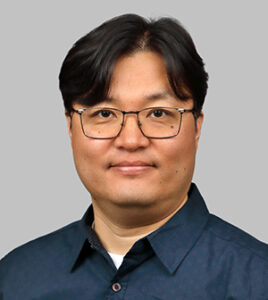Seong Won Lee, PhD
 Education
Education
- BS, Life Sciences and Biotechnology, Korea University
- PhD, Biological Sciences, Seoul National University
- Postdoctoral Study, Developmental Biology & Neuroscience, Washington University School of Medicine
Research Interest
Dr. Lee’s lab studies the genetic and molecular mechanisms underlying the effect of aging in human neurons. To understand how the aging of human neurons contributes to their vulnerability to neurodegeneration, Dr. Lee’s lab focuses on modeling the aging process with human neurons generated by a direct neuronal reprogramming (conversion) approach that can directly convert fibroblasts into neurons. Further, applying this conversion approach to longitudinally collected fibroblasts from the same individual, Dr. Lee’s lab investigates the key regulator of human neuronal aging in longitudinal modeling of all neuronal subtypes. Tissue culture systems of human fibroblasts and neurons are primarily used with genetic, molecular, and biochemical techniques to study human neuronal aging.
Selected Publications
- Oh YM*, Lee SW* (2024). Patient-derived neuron model: Capturing age-dependent adult-onset degenerative pathology in Huntington’s disease. Molecules and Cells, 47(4): 100046. *co-corresponding authors.
- Oh YM*, Lee SW*, Yoo AS (2024). Striatal neuronal models of Huntington’s disease via direct conversion: Modeling age-dependent disease phenotypes. Huntington’s Disease, 17;411-426. *co-first authors.
- Lee SW*, Oh YM*, Victor MB, Yang Y, Chen S, Strunilin I, Dahiya S, Dolle RE, Pak SC, Siverman GA, Perlmutter DH, Yoo AS. (2024). Longitudinal modeling of human neuronal aging reveals the contribution of the RCAN1–TFEB pathway to Huntington’s disease neurodegeneration. Nature Aging, 4;95-109. *co-first authors.
- Oh YM*, Lee SW*, and Yoo AS. (2023). Modeling Huntington disease through microRNA-mediated neural reprogramming identifies age-associated autophagy dysfunction driving the onset of neurodegeneration. Autophagy. 19(9);2613-2615. *co-first authors.
- Oh YM*, Lee SW*, Kim WK, Chen S, Church VA, Cates K, Li T, Zhang B, Dolle RE, Dahiya S, Pak SC, Silverman GA, Perlmutter DH, and Yoo AS. (2022). Age-related Huntington’s disease progression modeled in directly reprogrammed patient-derived striatal neurons highlights impaired autophagy. Nat. Neurosci. 25;1420-1433 *co-first authors.
- Lee SW, Oh YM, Lu Y, Kim WK, and Yoo AS. (2018). MicroRNAs overcome cell fate barrier by reducing EZH2-controlled REST stability during neuronal conversion of human adult fibroblasts. Dev. Cell. 2;73-4.
- Victor MB, Richner M, Olsen HE, Lee SW, Monteys AM, Ma C, Huh CJ, Zhang B, Davidson BL, Yang XW, and Yoo AS. (2018). Striatal neurons directly converted from Huntington’s disease patient fibroblasts recapitulate age-associated disease phenotypes. Nat. Neurosci. 21:341-352.
- Abernathy DG, Kim WK, McCoy MJ, Lake AM, Ouwenga R, Lee SW, Xing X, Li D, Lee HJ, Heuckeroth RO, Dougherty JD, Wang T, and Yoo AS. (2017). MicroRNAs induce a permissive chromatin environment that enables neuronal subtype-specific reprogramming of adult human fibroblasts. Cell Stem Cell. 21(3):332-348.e9.
- Park JH*, Lee SW*, Yang SW, Yoo HM, Park JM, Seong MW, Ka SH, Oh KH, Jeon YJ, and Chung CH. (2014). Modification of DBC1 by SUMO2/3 is crucial for p53-mediated apoptosis in response to DNA damage. Nat. Comm. 5:5483. *co-first authors.
- Lee SW, Lee MH, Park JH, Kang SH, Yoo HM, Ka SH, Oh YM, Jeon YJ, and Chung CH. (2012). SUMOylation of hnRNP-K is required for p53-mediated cell-cycle arrest in response to DNA damage. EMBO J. 31(23):4441-52.
Click here to see the full list of Dr. Lee’s work.
Grants
- Hereditary Disease Foundation Research Grant ($100,000, Co-PI, 03/01/2025~02/28/2026): The neuroprotective role of TET1 in Huntington’s Disease.
- National Research Foundation of Korea Travel Grant ($90,000, Co-Investigator, 03/01/2025~02/29/2028): Study on the role of lysosome-centric oxidative stress and zinc in understanding the pathogenesis of amyotrophic lateral sclerosis (ALS)